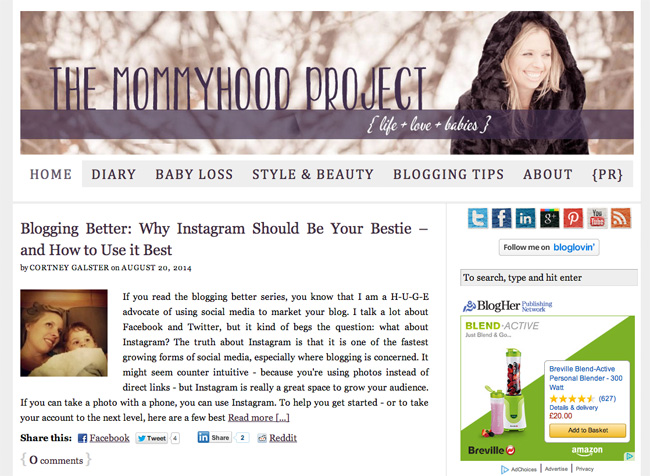Blogging is my life.
No, seriously. It is. I’ve been blogging since 2007, when I started out as a young gal just trying to get some writing experience after college. My blog was a combination of sports and fashion. A weird combination, but it was what both my job and free time revolved around at the time.
Blogging (and internet marketing) became such a passion, that I eventually made it my full time job. I work as a freelance blogger and marketing consultant both for my own site and with numerous clients. I’ve managed up to 50 blogs at a time for certain clients, depending on their industry and goals. It’s intense, I know.
From the perspective of my personal blog, my world changed when my husband and I became pregnant with our first child, right at the beginning of 2012. I knew that the world of sports and fashion just weren’t my life anymore – thus, The Mommyhood Project was born.

Starting a mommy blog during some of the biggest changes ever made to Google’s search algorithm was interesting – and it really made me rethink how I could build a successful personal brand and grow my audience. The last two and a half years have been full of learning experiences, with the end result being something pretty great.
For those who are building their blogging brand, you might feel like you’re in the middle of a completely overwhelming process. Don’t worry – every blogger feels that from time to time. With a few tips and a little focus, you’ll be able to overcome that overwhelmed feeling. To help you, I want you to take my experience and use it to your advantage. Here are six of the biggest things I’ve learned over the past 38 months on building a successful blog and social media following.
1. Consistency is Key
Over the last two years, I’ve built a substantial following both on my blog and on social media. Actually, the two are kind of related, but we’ll get to that.
For the first six months after I started The Mommyhood Project, I wrote about 14 posts a week, every week. I was consistently publishing and promoting multiple posts every weekday and usually one post per day on Saturdays and Sundays.
After Ricky was born, I just didn’t have time to create that much content, so I scaled way back and started posting much more irregularly. My audience dwindled – and by the time I realized the effect this was having on my traffic, it took me about nine months to build my site back up to the kind of monthly visitors I was seeing before. That hurt, big time.
Here’s the thing: Your audience is going to check your site more frequently if they know when you post. If you’re posting every Monday, readers will get used to that and visit your site once a week. If you’re posting multiple days a week, readers know they can find new content on your website much more frequently. And if you’re posting really sporadically, people won’t know when to look for your new articles and they actually forget that your site exists – which means they’re going to just move on to the next blog.
2. Identify Your Niche Persona
When I’m working with brands on developing a content strategy, the first thing I have them do is develop a persona for their target audience. If you want to create a successful blog, you need to do the same thing.
Think about your audience: what kind of niche category does your content fall into? Then start asking yourself questions to identify different characteristics of your target reader within that niche – like their age, gender, job, family size, interests and income. Doing this can help you envision who you’re writing to, which makes posting a lot easier.
This also makes it easier to target your content to the right people. When your content is highly targeted, it can still speak to a broader audience – but the niche market you really want to attract is more likely to become loyal to your blog and share your work with others from the same demographic.
3. Make Social Media Your Best Friend
Do you want to know a secret? I spend more time on social media than I do actually creating content – and I spend it connecting with a lot of people that I don’t actually know in real life. This is to help curate my audience by engaging with them outside of the articles I write.
Many bloggers are actually a little afraid of social media – which is a big hurdle that you need to overcome if you want to have a successful blog. Some of the biggest issues I see from a networking perspective is writers making their social media accounts private, not engaging with people outside of their real life friend base and posting nothing but links to their own work.
This is not an effective social media strategy.
You need to start thinking of yourself as the mayor of your community – both on your blog and on social media. Reach out to people who you think would really like your work. Connect with other bloggers that you can engage with (and get in front of their social media following). Go beyond just posting links to your work – use social networks as a tool for engaging with your followers (hint: this helps attract more followers to your account).
Another thing you can do is search by hashtag to find users that fall into your target audience category. For example, there’s a trend on Instagram for fashion bloggers to post an outfit of the day using the hashtags #ootd (short for outfit of the day) or #wiw (short for what I wore). If you’re a fashion blogger, not only is this a great trend to keep your blog relevant – it’s also a great way to connect with the exact people that would be interested in what you’re writing about.
4. Maximize Your Content
While we’re on the subject of social media, let’s talk a little about linking best practices. Yes, you need to have non-link updates on your social media accounts. But the whole point of being the mayor of social networking is to get people to visit your site, right?
Every time you post a new article, you should share it on social media right away – I’m guessing you already know this. The real trick is figuring out how to share your content multiple times. Over the course of a week, I share every new article on my site six or seven times. I change up the messaging for each post so that it doesn’t get stale. I also use Hootsuite, a free social media management platform, to schedule and publish my linked posts for the week.
Using Hootsuite helps me to intersperse non-linked content on my social media sites with my linked updates. It also helps me to better manage my time on social media. In my experience, this simple step can help you increase site traffic by 25 percent right away.
5. Guest Post, Guest Post, Guest Post
It’s a lot easier to write content for your own site than it is for someone else’s – I get that. But writing content for a site that reaches an audience similar to yours is a great way to gain exposure a group of readers who otherwise wouldn’t know about you. It’s also a great way to build up links from other sites that link back to your own blog (backlinks) for search engine optimization (SEO) purposes.
When you’re looking for sites to guest post on, think back to that persona that you identified earlier. What blogs and sites does that person visit on a regular basis? Maybe it’s an industry site, maybe it’s an online news site or maybe it’s another blog.
Once you’ve identified a few places you think that person is visiting, start emailing the editors of those sites and ask if they accept guest submissions. If they say yes, start submitting story ideas and content
6. Create an Editorial Calendar
So, now that you’re creating all of this content, how do you manage it? The easiest way is to create an editorial calendar. My personal preference is to use Google docs, because I can access my calendar spreadsheet no matter where I am – and I don’t have to keep re-saving it between my computers.
I like to update my editorial calendar at least once a day – since article ideas and guest submission opportunities can hit at any time, this is how I remember everything I have going on. Once I write and post an article, I highlight it on the calendar so that I know it’s totally done. At the end of the week, I remove the old articles to keep the document from getting too crazy.
This is also a great way to help minimize writer’s block. Some days you’re going to have more ideas than others, that’s just the way blogging works. By knowing what you’re going to write in advance, you don’t have to worry about thinking up new story ideas every single day. It’s also a great way to hold yourself accountable to your posting schedule.
7. Put Your Head Down and Focus
Sometimes it feels like there’s just not enough time in the day to get to your blog. If you want to be a successful blogger, you need to figure out how to make the time and just focus on creating great, valuable content for your readers. Taking away distractions like social media, texting on your phone or checking your email can help.
Other distractions – like spending time figuring out how successful “competing” bloggers are and what their social media following looks like – can be a great way to motivate yourself to continue building your own blog and social following. But at some point, you have to stop focusing on what everyone else is doing and just work on your own content.
Building a successful blog isn’t easy – to be honest, it’s a lot of hard work. But if you’re willing to put in the hours to build your brand and your following, you’ll reap the rewards down the road. I’ve built my entire career based on starting a rinky-dink blog back in my early 20’s. Believe me when I tell you that if you set yourself up for success, you can most certainly achieve your blog goals as well.
Cortney


